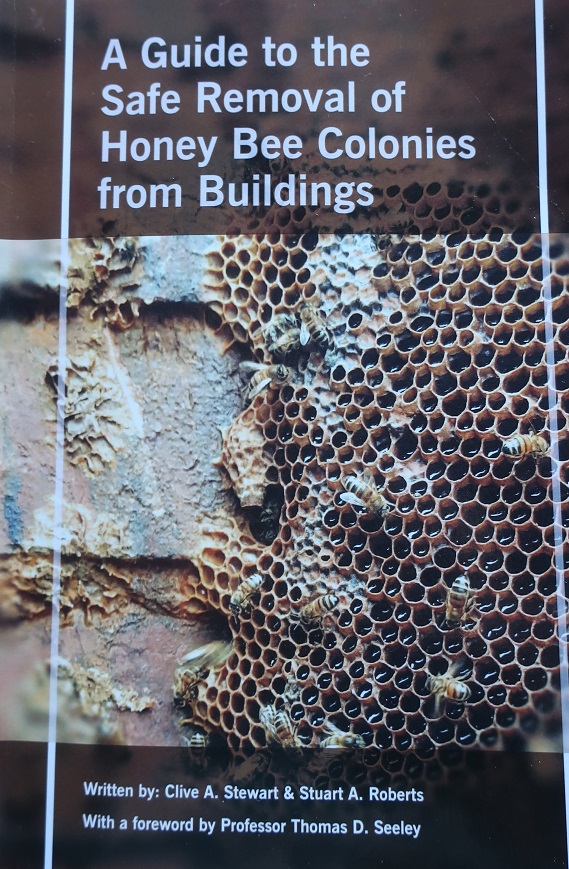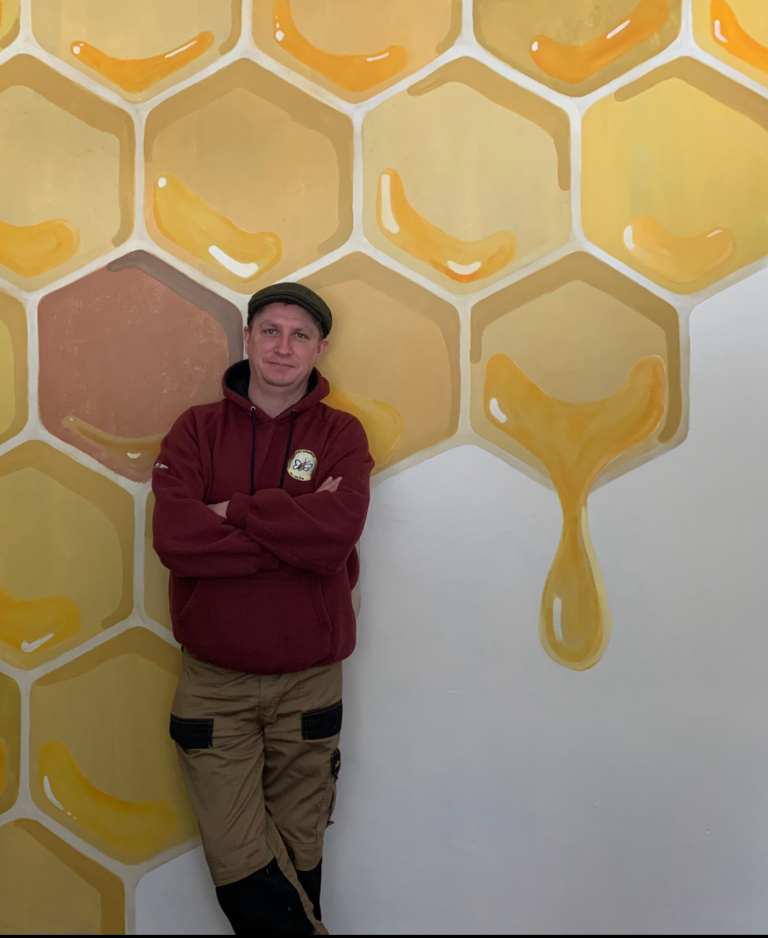
Have you ever been asked to remove a colony of honey bees from a building? I have; lots of times, but knowing as much as I do now, I decline and refer the job on to a professional with insurance.
Learning from the Past.
I’m not proud of a botched job from the distant past that my bee buddy and I attempted. Cynthia and I have been beekeeping for about the same long time and we are older and wiser. I was four years ahead of her when she started and was at the stage where you think you know a lot about bees and can take on anything. To be fair we invited a much more experienced beekeeper to join us remove a colony from a friend’s loft and discovered very quickly that he didn’t have a clue about tackling efficiently it either.
I’ll spare the details but suffice to say it didn’t end well for the bees. We both have vivid memories of honey dripping through the ceiling and very angry bees engulfing us. One of us, sporting a new short jacket and veil, gave a terrific performance of a highland fling on the landing before squelching downstairs to change into a full suit and plastic bags over shoes and ankles.
If I’d read the A guide to the Safe Removal of Honey Bee Colonies from Buildings you wouldn’t have heard that last story.

Many years later, I had the good fortune to run into Clive Stewart on a beekeeping course and discover that he is a professional specialist bee remover with his own business https://www.westart-apiaries.co.uk/. I was fascinated to learn about his work, and some of you may remember his guest blog not long after I launched the Beelistener website,Clive Stewart’s Bee Removal Guest Blog. (beelistener.co.uk) . Clive set up the UK Bee Removers Group on Facebook https://www.facebook.com/ukbeeremovers/. Along with another friend of mine and author, Stuart Roberts, https://www.northernbeebooks.co.uk/products/100-plants-for-beekeepers-roberts/, Clive has written the definitive handbook on removing bees safely from buildings. I’ve reviewed this book for you and can honestly say that it is one of the best books I have read in ages.
Look out for bee removal courses coming soon to Scotland. Hopefully this duo will put on a roadshow in the UK and show us how it’s done.
Review.
Title: A Guide to the Safe Removal of Honey Bee Colonies from Buildings by Clive A. Stewart & Stuart A. Roberts.
Published: 2022 by Northern Bee Books.
ISBN: 978-1-914934-50-6.
Paperback, 128 pages.
Cost: £17.99.
Available: Northern Bee Books. https://www.northernbeebooks.co.uk/products/a-guide-to-the-safe-removal-of-honey-bee-colonies-from-buildings-stewart-and-roberts/
A Guide to the Safe Removal of Honey Bee Colonies from Buildings by Clive A. Stewart & Stuart A. Roberts is the handbook that the beekeeping world has been long awaiting. It is exactly as the title suggests, but written in much more depth and detail than one might expect for the price. This is truly good value for your money.
The front and back of the attractive glossy cover contain beautiful photographs, and inside there are many excellent well produced photographs supporting the text and demonstrating clearly the various situations discussed. The font and layout are pleasing to the eye, and the quality paper feels satisfying to touch. This book will be taken out into the field and well- thumbed so the reader may want to keep another clean copy at home.
The foreword by Professor Tom Seeley has been thoughtfully written, and the contents page guides the reader through six parts. The book is written in a warm, friendly style, and peppered with good humour. It almost feels as if the authors are right there talking you through the processes. They are real professionals with much experience and over 36 years practical beekeeping between them.
This is one of the most detailed practical handbooks on the bookshelves, and the authors demonstrate great respect and compassion for the welfare of honey bees and the houseowners from whose buildings the bees are taken. Health, hygiene and safety are key, and how to secure them and reduce risks are main themes from cover to cover.
Part One introduces the natural history of the honey bee and the behaviour involved with swarming which is essential knowledge for anyone in the bee removal business. It is concise and to the point and written in an easy- to- understand style.
Part Two addresses health and safety and the importance of planning ahead and making a detailed survey before starting the job. “Preparation, preparation, preparation” echoes throughout this gem of a book. There is so much good advice from taking photographs of the removal for clients, rather have them looking on and taking risks, to never using ladders as working platforms. The salutary reminder that houses are potentially dangerous places to work, and that there are ca. 4500 deaths annually from asbestos every year in the UK, makes the reader aware that honey bee removers must be adequately trained for the job. The various insurance cover policies required are explained in detail.
Part Three explains how to assess colonies in buildings before removal and gives accounts of all the equipment needed and the history of their development which the reader will find fascinating. We learn that a thermal camera is essential and it was invented in 1929 as part of air defence following WW1. The bee removalist can use one on their Smartphone. Anyone who thought that endoscopes belonged exclusively in hospitals will be surprised to learn how they are also used in bee removal operations.
Part Four discusses colony removal from different parts of buildings and trees. In some situation these colonies have become a public health nuisance but, interestingly, as many colonies remain in situ as are removed. We learn that the longer a colony remains in a chimney the further down they travel to build comb. A nest can grow by a foot a year.
The reader is given guidance on physically removing the comb and attaching it to frames. “Removing the comb and bees together gives the colony the optimal chance of survival”. The amount of equipment that a bee removalist requires is massive and the authors give a comprehensive list with an explanation of how each piece works. The authors even think of advising on carrying a spare pair of shoes, and the importance of attention to cleanliness, detail, and protecting property is emphasised.
Part Five presents case studies and talks the reader through planning a colony removal.
Part Six summarises and concludes this work with a reminder of the key salient points made previously. The reader is advised that this book is not a substitute for formal training and is given a relevant reminder that “the vocation for beekeeping is potentially no longer about saving bees, but more about responsible beekeeping.”
The book will become part of the essential kit of a bee removalist, but it will also end up on many hobby beekeeper bookshelves and local association libraries. It is a timely reminder that bee removals should only be tackled by well- trained insured specialists.

Thank you, Ann, for helping spread the word about this book. I do like very much how it contains detailed information about ways to perform removals of wild colonies from buildings in ways that are good for both human beings and honey bees. Win-win methods!
Great article Ann on an important subject i.e. dealing with wild bees as kindly as you can when they have inadvertantly taken up residence where they shouldn’t have!!!! It sounds as if such a helpful book will fill an important roll in the modern Bee Keepers learning tools.I very much enjoyed reading about it.Best Wishes Aye Mairi x
Hello Mairi. Thank you for commenting on this article and appreciating the care and sensitivity of the authors. It must be hard in your country as hundreds of wild potentially varroa- ridden colonies are destroyed. I hope that the Parramatta Gaol tree colony is still thriving. Best wishes, Ann.